Định hướng hoàn thiện hoạch định thị trường chiến lược của doanh nghiệp thương mại nội địa
Việc hoạch định thị trường chiến lược ngày càng nhận được nhiều sự quan tâm của các
nhà khoa học và các chuyên gia kinh doanh, khi môi trường kinh doanh ngày càng thay đổi nhanh
chóng, phức tạp và khó lường. Hoạch định thị trường chiến lược được đánh giá là có tính thích
ứng cao và linh hoạt, tích hợp các kế hoạch của các cấp trong doanh nghiệp, từ đó đạt được mục
tiêu thị trường, tạo dựng và phát triển vị thế cạnh tranh. Tiềm năng tăng trưởng cao của thị
trường nội địa đã thúc đẩy các doanh nghiệp thương mại sớm áp dụng hoạch định thị trường
chiến lược, cũng như thay đổi công nghệ, nâng cao chất lượng và đa dạng hóa sản phẩm. Trên
cơ sở đánh giá chung về thương mại trong nước, bài viết tập trung làm rõ thực trạng hoạch định
thị trường chiến lược của các doanh nghiệp thương mại trong nước, từ đó xem xét và đề xuất
một số giải pháp hoàn thiện công tác này.
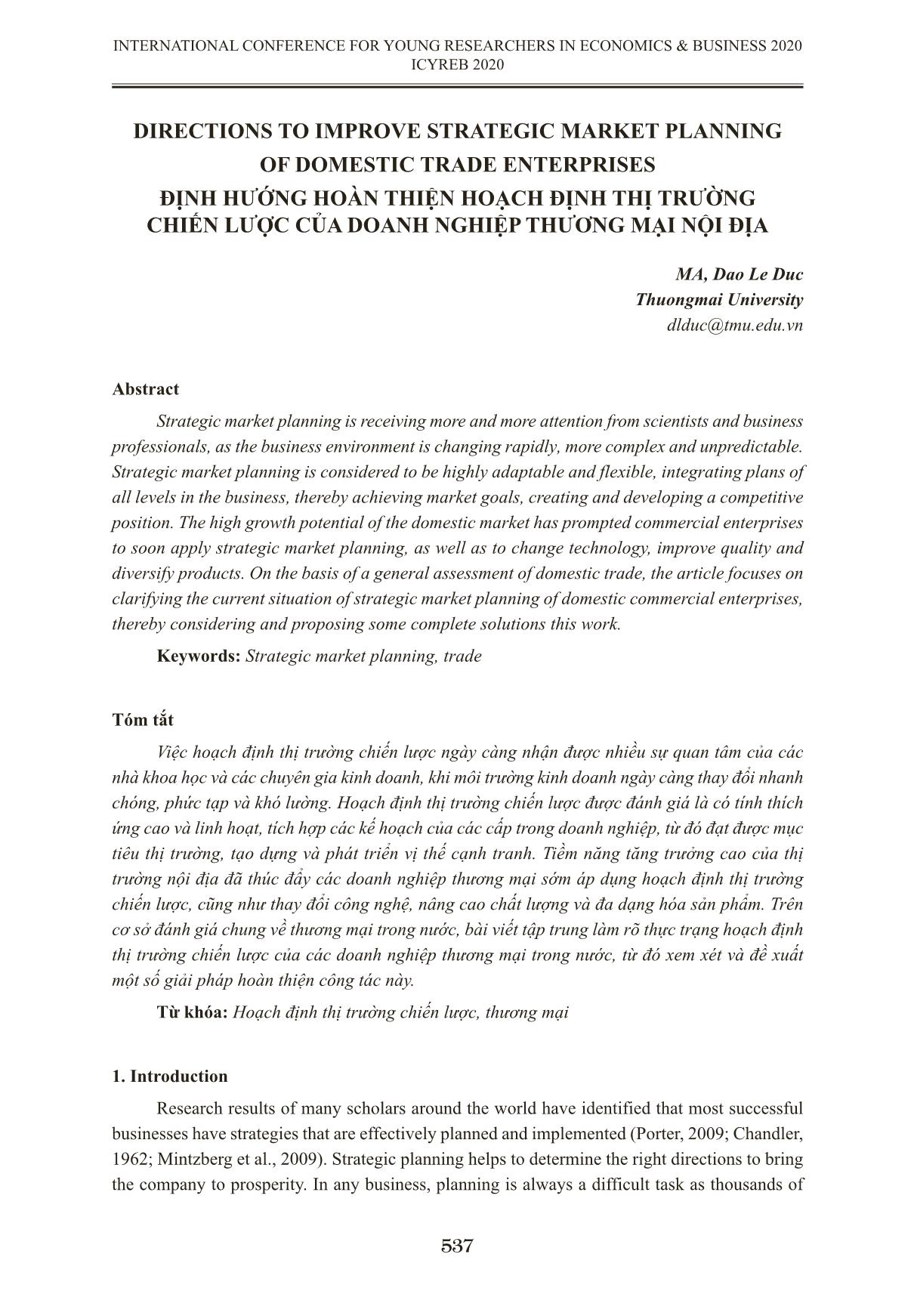
Trang 1
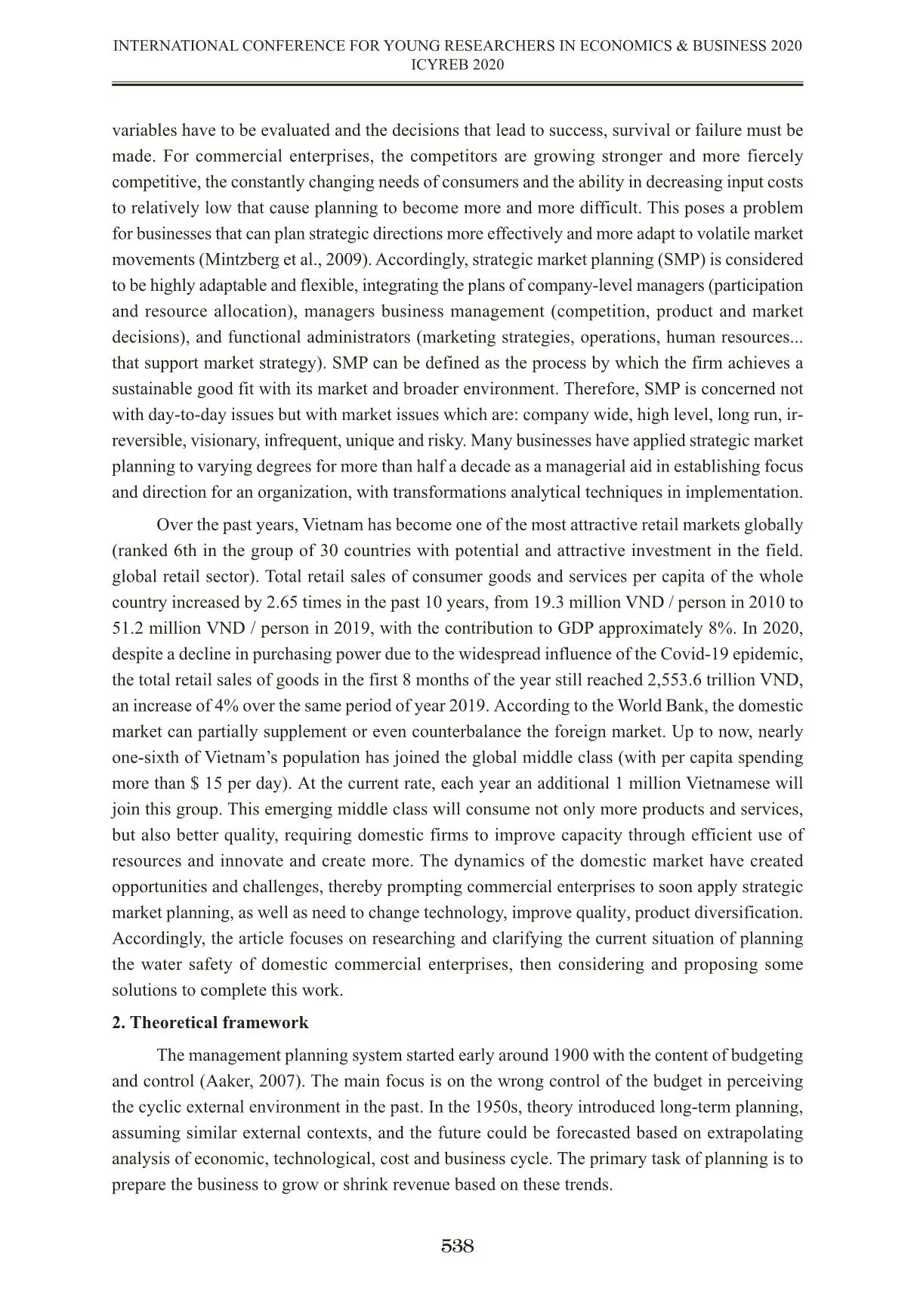
Trang 2

Trang 3
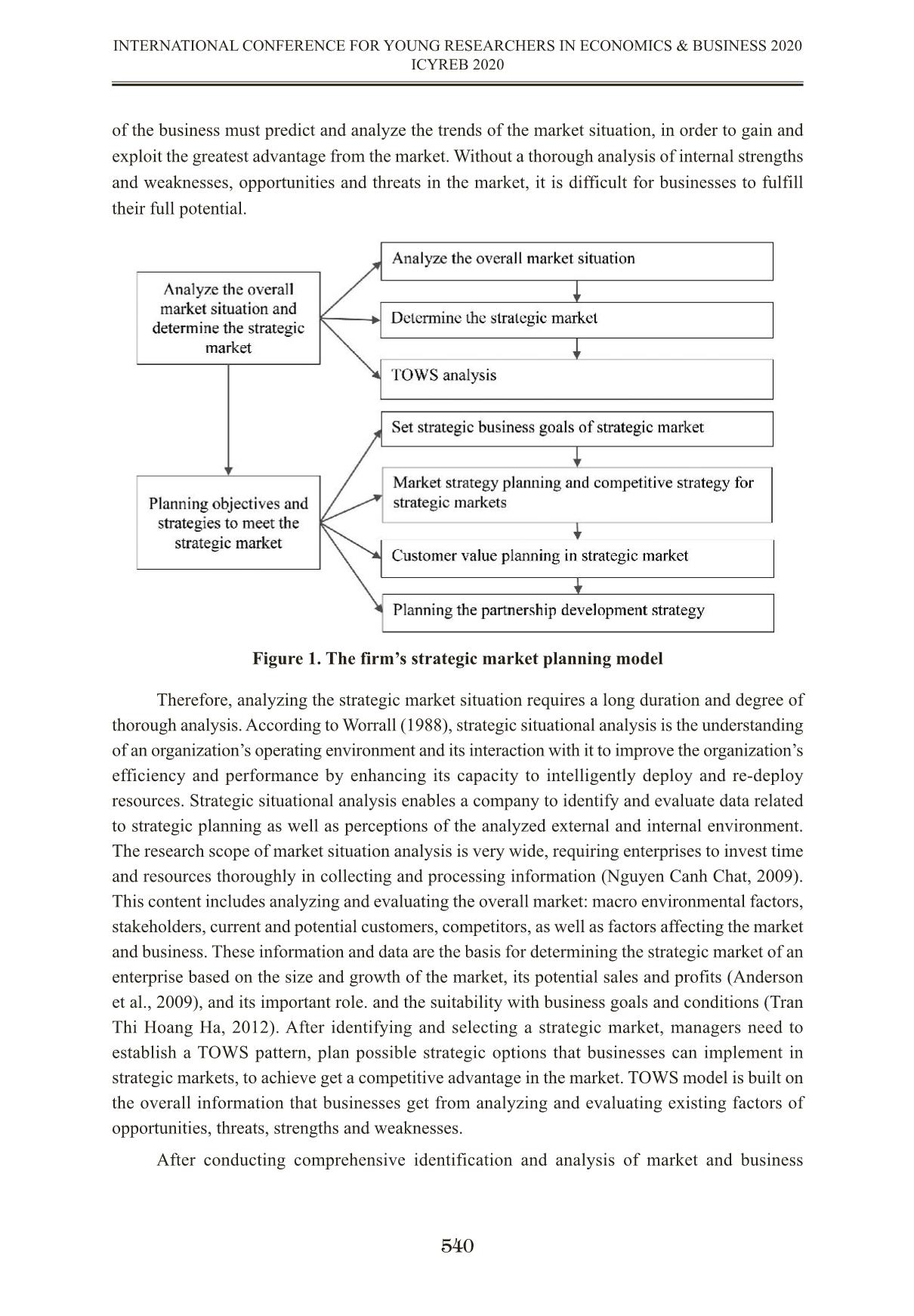
Trang 4
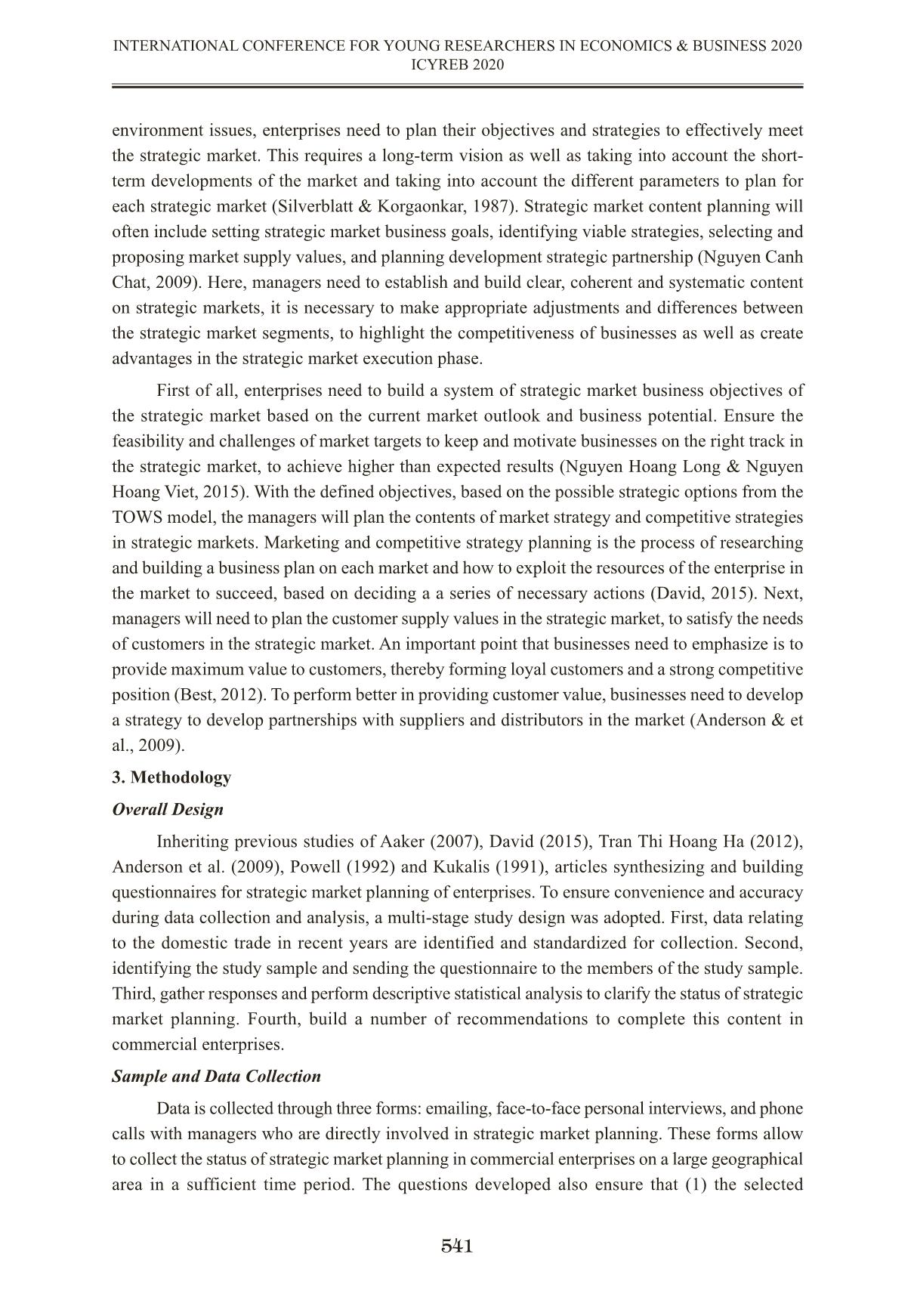
Trang 5
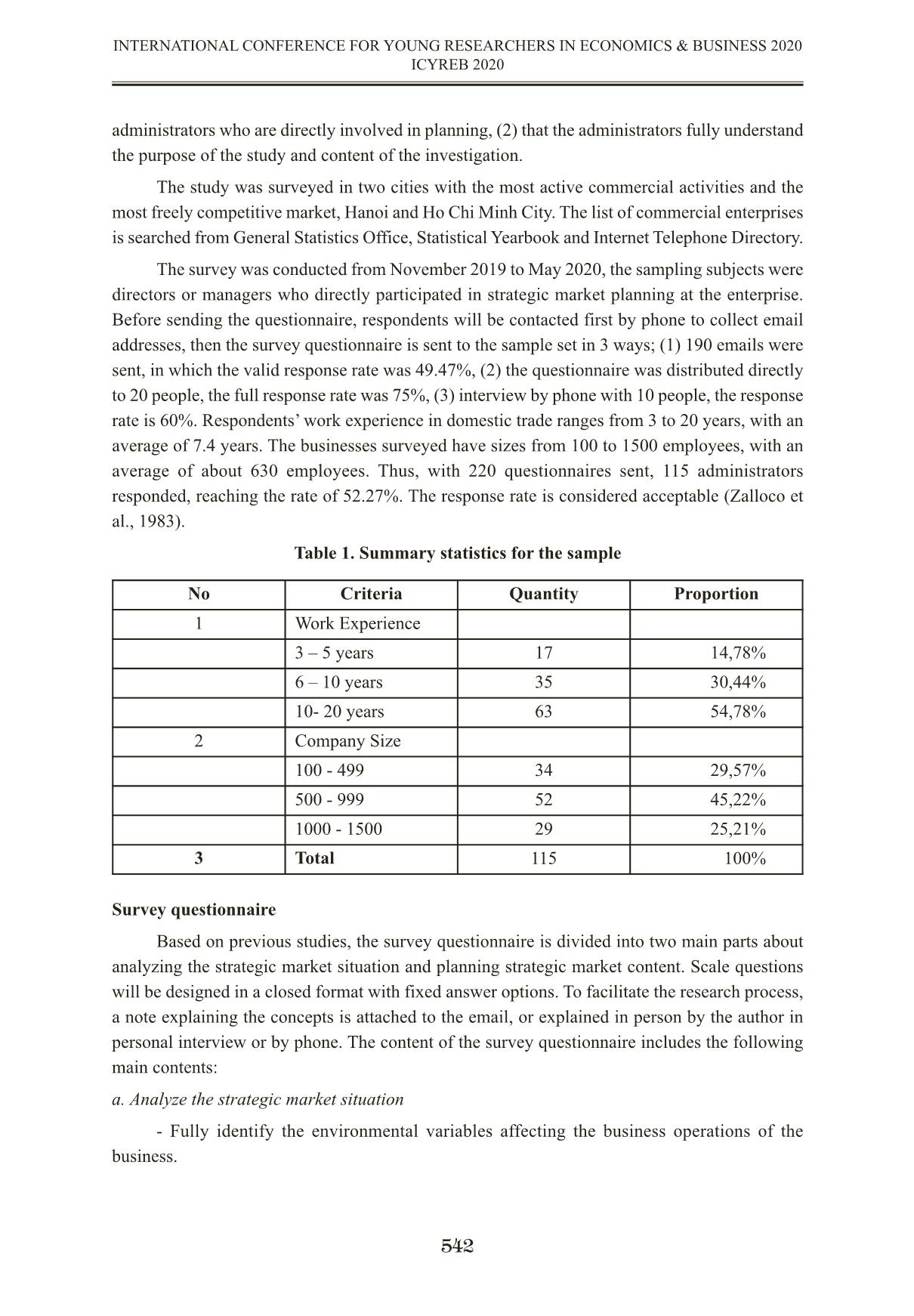
Trang 6
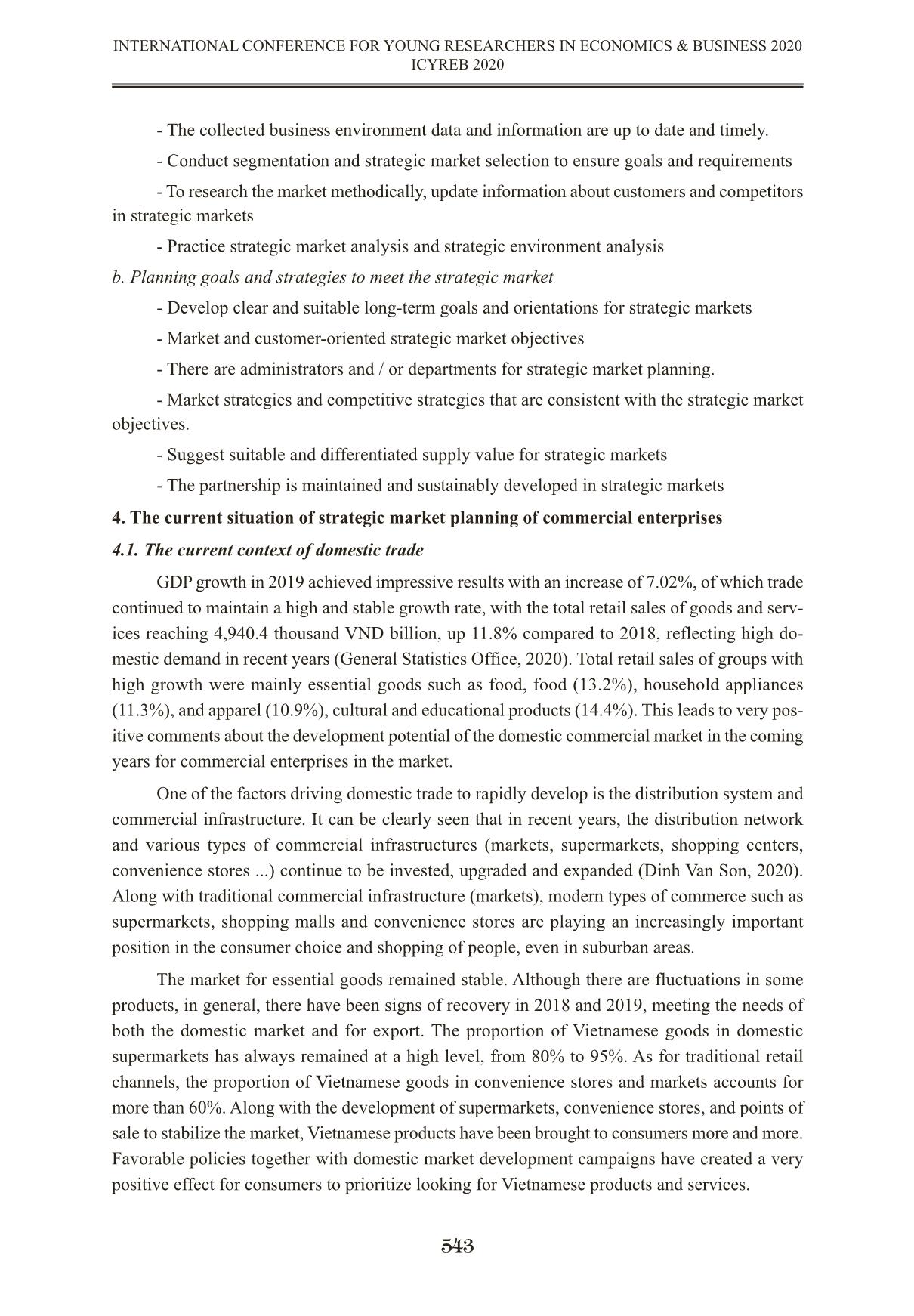
Trang 7
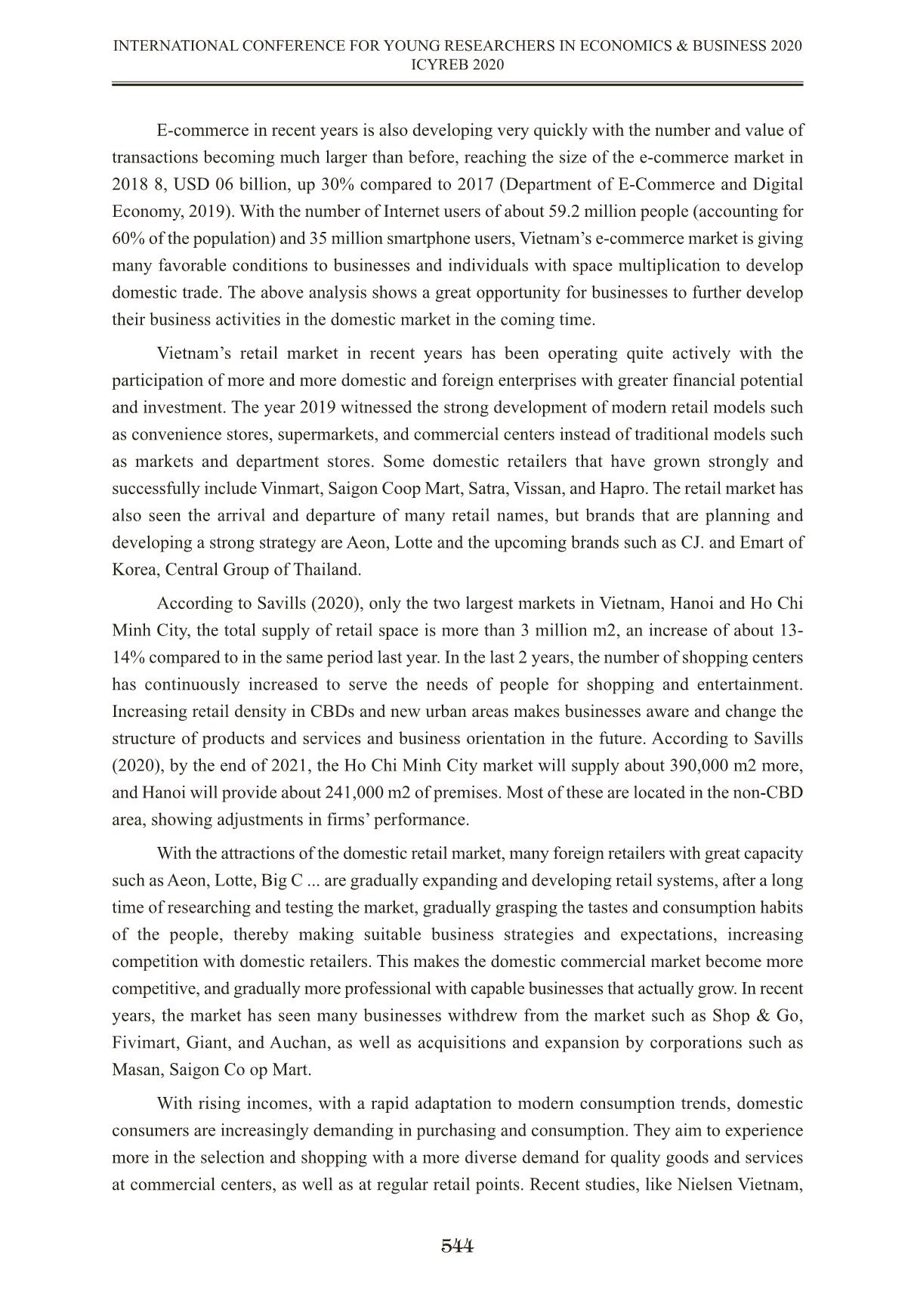
Trang 8
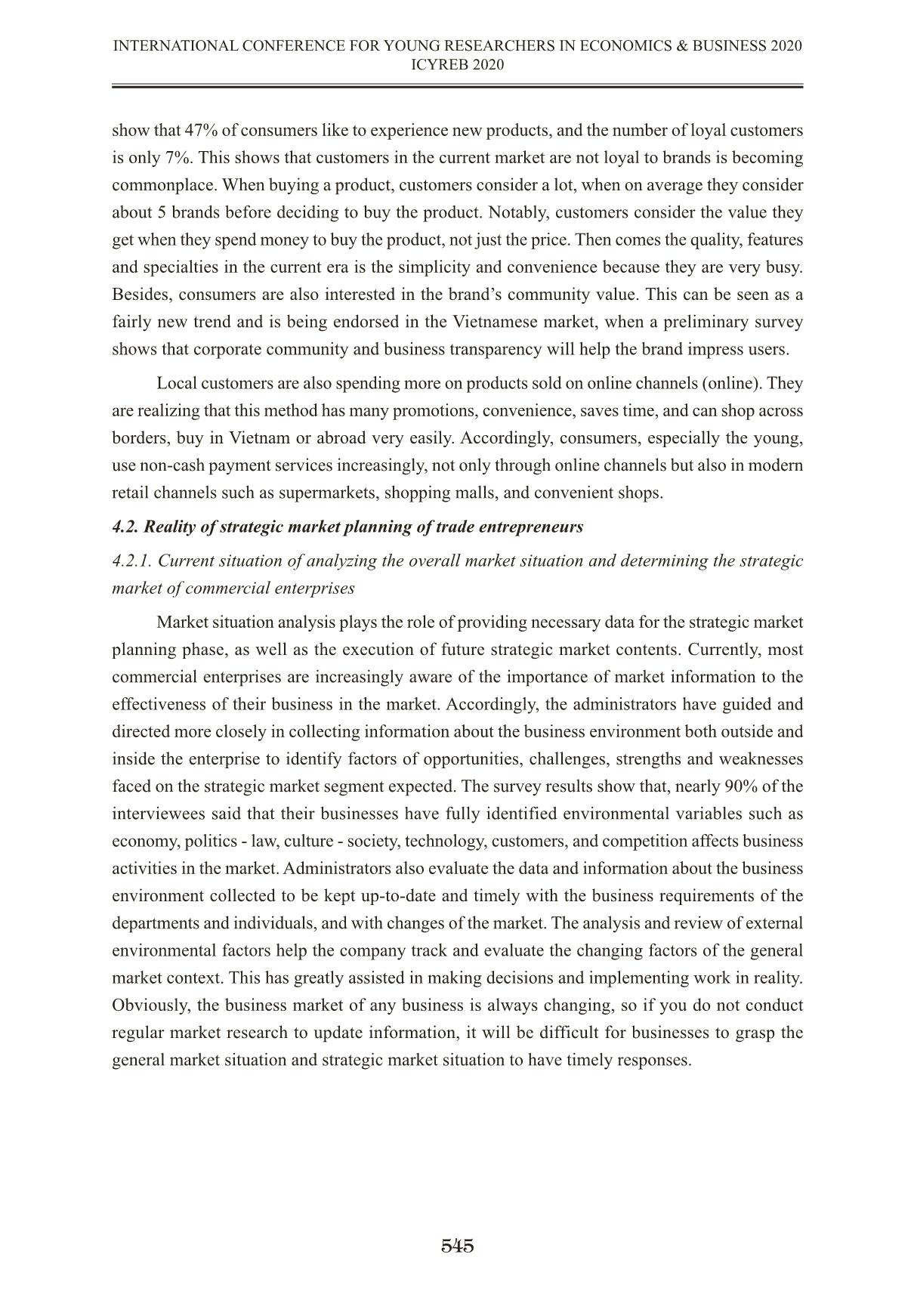
Trang 9
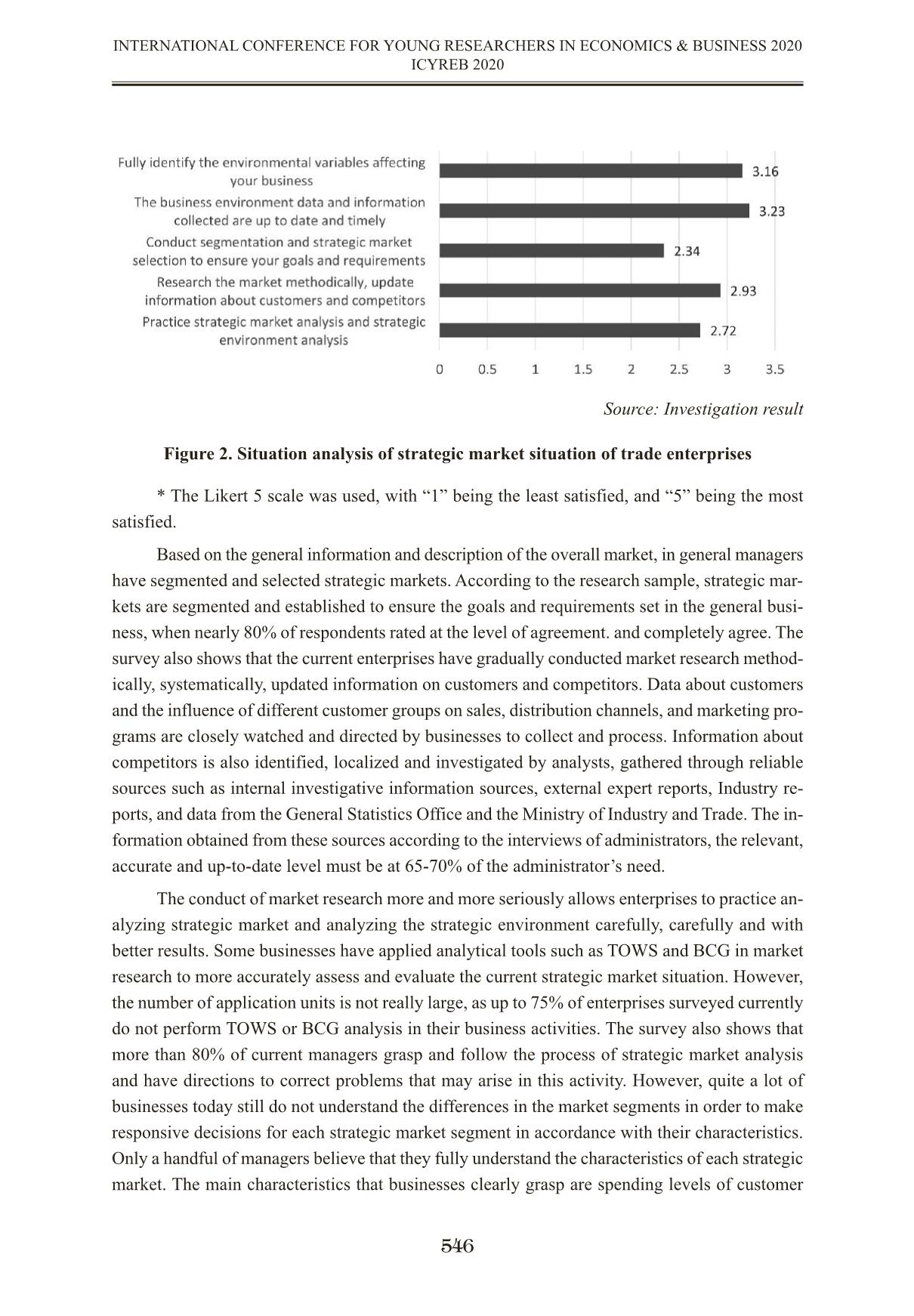
Trang 10
Tải về để xem bản đầy đủ
Tóm tắt nội dung tài liệu: Định hướng hoàn thiện hoạch định thị trường chiến lược của doanh nghiệp thương mại nội địa
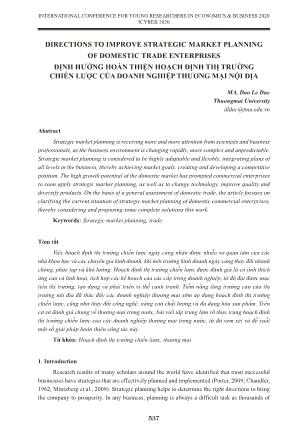
DIRECTIONS TO IMPROVE STRATEGIC MARKET PLANNING OF DOMESTIC TRADE ENTERPRISES ĐỊNH HƯỚNG HOÀN THIỆN HOẠCH ĐỊNH THỊ TRƯỜNG CHIẾN LƯỢC CỦA DOANH NGHIỆP THƯƠNG MẠI NỘI ĐỊA MA, Dao Le Duc Thuongmai University dlduc@tmu.edu.vn Abstract Strategic market planning is receiving more and more attention from scientists and business professionals, as the business environment is changing rapidly, more complex and unpredictable. Strategic market planning is considered to be highly adaptable and flexible, integrating plans of all levels in the business, thereby achieving market goals, creating and developing a competitive position. The high growth potential of the domestic market has prompted commercial enterprises to soon apply strategic market planning, as well as to change technology, improve quality and diversify products. On the basis of a general assessment of domestic trade, the article focuses on clarifying the current situation of strategic market planning of domestic commercial enterprises, thereby considering and proposing some complete solutions this work. Keywords: Strategic market planning, trade Tóm tắt Việc hoạch định thị trường chiến lược ngày càng nhận được nhiều sự quan tâm của các nhà khoa học và các chuyên gia kinh doanh, khi môi trường kinh doanh ngày càng thay đổi nhanh chóng, phức tạp và khó lường. Hoạch định thị trường chiến lược được đánh giá là có tính thích ứng cao và linh hoạt, tích hợp các kế hoạch của các cấp trong doanh nghiệp, từ đó đạt được mục tiêu thị trường, tạo dựng và phát triển vị thế cạnh tranh. Tiềm năng tăng trưởng cao của thị trường nội địa đã thúc đẩy các doanh nghiệp thương mại sớm áp dụng hoạch định thị trường chiến lược, cũng như thay đổi công nghệ, nâng cao chất lượng và đa dạng hóa sản phẩm. Trên cơ sở đánh giá chung về thương mại trong nước, bài viết tập trung làm rõ thực trạng hoạch định thị trường chiến lược của các doanh nghiệp thương mại trong nước, từ đó xem xét và đề xuất một số giải pháp hoàn thiện công tác này. Từ khóa: Hoạch định thị trường chiến lược, thương mại 1. Introduction Research results of many scholars around the world have identified that most successful businesses have strategies that are effectively planned and implemented (Porter, 2009; Chandler, 1962; Mintzberg et al., 2009). Strategic planning helps to determine the right directions to bring the company to prosperity. In any business, planning is always a difficult task as thousands of 537 INTERNATIONAL CONFERENCE FOR YOUNG RESEARCHERS IN ECONOMICS & BUSINESS 2020 ICYREB 2020 variables have to be evaluated and the decisions that lead to success, survival or failure must be made. For commercial enterprises, the competitors are growing stronger and more fiercely competitive, the constantly changing needs of consumers and the ability in decreasing input costs to relatively low that cause planning to become more and more difficult. This poses a problem for businesses that can plan strategic directions more effectively and more adapt to volatile market movements (Mintzberg et al., 2009). Accordingly, strategic market planning (SMP) is considered to be highly adaptable and flexible, integrating the plans of company-level managers (participation and resource allocation), managers business management (competition, product and market decisions), and functional administrators (marketing strategies, operations, human resources... that support market strategy). SMP can be defined as the process by which the firm achieves a sustainable good fit with its market and broader environment. Therefore, SMP is concerned not with day-to-day issues but with market issues which are: company wide, high level, long run, ir- reversible, visionary, infrequent, unique and risky. Many businesses have applied strategic market planning to varying degrees for more than half a decade as a managerial aid in establishing focus and direction for an organization, with transformations analytical techniques in implementation. Over the past years, Vietnam has become one of the most attractive retail markets globally (ranked 6th in the group of 30 countries with potential and attractive investment in the field. global retail sector). Total retail sales of consumer goods and services per capita of the whole country increased by 2.65 times in the past 10 years, from 19.3 million VND / person in 2010 to 51.2 million VND / person in 2019, with the contribution to GDP approximately 8%. In 2020, despite a decline in purchasing power due to the widespread influence of the Covid-19 epidemic, the total retail sales of goods in the first 8 months of the year still reached 2,553.6 trillion VND, an increase of 4% over the same period of year 2019. According to the World Bank, the domestic market can partially supplement or even counterbalance the foreign market. Up to now, nearly one-sixth of Vietnam’s population has joined the global middle class (with per capita spending more than $ 15 ... pabilities of their busi- ness units. Survey results show that more than 69% of managers only cover activities in their fields, but do not have an overall view of the entire operation of the business, as well as have good connections with other parts. Therefore, the construction of targets based on an imposing one-way process has caused many administrators to lack review and discuss the assumptions on the stock market, so it is not possible to define the individual customer base for each stock ex- change, as well as lack of adaptation to market situations. 547 INTERNATIONAL CONFERENCE FOR YOUNG RESEARCHERS IN ECONOMICS & BUSINESS 2020 ICYREB 2020 b. Situation of market strategy and competitive strategy for strategic market With the awareness of the importance of strategic market planning, the managers of com- mercial enterprises have now researched and proposed market strategic directions and competitive strategies for the above enterprises. strategic market. However, the actual investigation results show that the level of strictness and normality in this content is not really high and popular. Only about 30% of businesses have long-term market strategy plans, the rest only stop at annual or short-term planning in strategic markets (2-3 years), and there are still few units have almost no directions and market strategy documents. With such limitations, so many businesses do not really have a clear division of managers and/or specialized departments for strategic market planning activities. The content of strategic market planning is mostly integrated in the documents of gen- eral plans and strategies. The survey results show that only 11% of businesses have managers who are responsible for and closely follow strategic market planning content, while the number of businesses with managers and/or ministries part-time and integration of strategic market plan- ning tasks and businesses that do not have this department account for 61%. Source: Investigation result Figure 4. Current state of resources for strategic market planning c. The real situation of customer supply value for the strategic market Commercial enterprises depend on their size, field of operation, capacity to choose and po- sition certain values to provide customers. Preliminary investigation shows that managers are based on the wants and needs of customers to choose and provide values for customers. Most of them have done a list of information customers need to track and predict about current and future needs and wants. Based on the data obtained from customer analysis lists, strategic market man- agers made careful assessments of the value and relevance of the proposed customer values, as well as examining the actual ability of the internal business to plan the value supply to customers in the strategic market. 548 INTERNATIONAL CONFERENCE FOR YOUNG RESEARCHERS IN ECONOMICS & BUSINESS 2020 ICYREB 2020 Source: Investigation result Figure 5. Degree of perceived differences in the value of supply to strategic markets The survey results show that 100% of enterprises carry out identification, selection and positioning of supply value in strategic markets. However, the level of difference of customer values that businesses choose to supply is not much between strategic markets, and there is not really any homogeneity of customer value analysis and assessment methods. Only 12% of re- spondents think that the proposed value of supply is appropriate and different for strategic mar- kets, while this figure is 36% and 52% respectively for the two “suggested supply value, there are some differences for strategic markets” and “not making differences to strategic markets”. This is shown through most businesses trying to provide the basic customer values such as “for people”, “low cost”, “quality”, “reputation”, “brand”, “satisfying customers’ choice”, “conve- nience”, “freshness”, and “style”. Thus, it can be seen that managers have somewhat basic think- ing and methods in identifying, analyzing, forecasting and selecting customer values, but applying it to the practice of the enterprises’ planning on the market are not really scientific, methodical and professional. d. Situation of partnership development strategy planning To operate a smooth flow of goods, access to customers smoothly, and expand markets, businesses need to build and develop a good relationship with suppliers and distribution inter- mediaries. At this point, it can be said that this partnership is considered an intangible asset of the business, holding an important position in all areas of the business, as it directly affects quality of product/services, supply methods, thereby affecting business results of enterprises. Therefore, all businesses have been closely involved in cooperating and keeping relationships closer. In re- cent years, businesses have made judgments, analyzes and assessments to better understand the strengths, limitations as well as the needs and desires of suppliers and distributors. plan appro- priate relationship management and communication methods. This helps them plan the basics of how to work with partners, follow the business operation process, from purchasing to production and selling in the market. 549 INTERNATIONAL CONFERENCE FOR YOUNG RESEARCHERS IN ECONOMICS & BUSINESS 2020 ICYREB 2020 Source: Investigation result Figure 6. Current Status of Partnership Development in Strategic Market 5. Orientation to plan in the future With the current situation in strategic market planning, in order to complete this content, commercial enterprises can synchronously deploy a number of solution orientations as follows: Firstly, in order to effectively plan a strategic market, enterprises need to perform well the analysis of the strategic market situation, to be able to fully and accurately assess and evaluate developments, changing the development trend of the market, the competitive environment and the business landscape of the business. Accordingly, the strategic market managers can allow the application of a number of strategic environmental analysis tools such as integrated analysis models of external factor environmental (EFE) and the internal factor environment (IFE), the SPACE matrix, the BCG matrix, the GS matrix, the TOWS matrix. Based on these tools, along with regularly collecting and updating information, strategic market managers will have the amount of data needed to plan and adjust strategic markets. Second, setting up reasonable long-term strategic market targets is important and necessary for the deployment of corporate action content in strategic markets. Therefore, executives should formulate long-term strategic market goals with consultation from the five approaches to which are senior executives, shareholders, the business itself, competitors and environment. Consultation from these five groups allows managers to have a more complete view of their current business performance, as well as future growth prospects. Managers tend to be loyal to previous goals, shareholders want to outpace existing results such as sudden growth, competitors act as target parameters, the business itself plays a fundamental role, and the environment reflects what to do. Therefore, in the process of setting long-term strategic market goals, enterprises need to do this at all three strategic levels within the enterprise to ensure connectivity, inheritance and synchronization across markets. strategy. Third, in market strategy planning and competitive strategy, managers need to quickly update and apply the knowledge of modern business administration. Since then, there is the right understanding and application of the process of strategic planning, models and tools for strategic selection in the context of technology 4.0 and the current broad level of economic integration. Along with that, the selected strategic plans need to have discussion and evaluation of managers in the business, from the Board of Directors, the Board of Directors to the administrators at all 550 INTERNATIONAL CONFERENCE FOR YOUNG RESEARCHERS IN ECONOMICS & BUSINESS 2020 ICYREB 2020 levels. The economic arguments of each strategic plan must show the great economic benefits that the strategy brings and the feasibility of that plan. The selected strategic plans also need to create a superiority in the capabilities of the business and differentiate from competitors. Fourth, when identifying the strategic market, enterprises must choose and supply values that match the wishes of customers in each strategic market. This requires businesses to clearly identify customers’ needs, motivations, habits and buying behavior. Accordingly, businesses need to build a clear step-by-step plan, through each stage, what changes, how will customer values need to be changed, upgraded, and renewed in the strategic market. Strategic market managers need to answer the questions “what determines customer value in many different segments”, “how customer value is measured”, “how information technology can be used to increase customer value”,”how current trends in customer value affect supply positioning”, “smart pricing strategies can be used to enhance performance”. Offering an answer to these questions is that the business has selected for itself distinct values for the strategic market segment, thereby giving the appropriate positioning quality through its marketing efforts. Fifth, businesses need to organize their supply chain and manage a cooperative supply chain. Cooperation in the supply chain will encompass the full commitment of time, information sharing, risks and bilateral benefits from the relationship. Accordingly, managers can follow a number of things such as: (1) information on consumer demand is widely shared among all stakeholders in the supply chain, (2) using media Joint transport to maximize the efficiency of two-way transport and streamline routes to reduce transportation costs, (3) rural areas will also have distribution centers with the same role as distribution centers in the city, (4) points of distribution will be conveniently located to deliver goods to consumers quickly, such as delivery to residential retail locations, or delivery points of high building 6. Conclusion The changing business environment is clearly putting businesses in a adaptive spiral to compete. Strategic market planning is seen as an effective tool to ensure a successful business’s long-term market directions. However, this is not a simple piece of content, and the effective adoption of the real-world planning process will often take weeks or longer (gathering information is a year-round process). Therefore, businesses need to carry out strategic market planning bit by bit and more accurately and ensure full awareness of the importance of strategic market planning at all levels of the organization. In this article, the author has assessed the current state of strategic market planning of commercial enterprises. Based on the assessment results, a number of recommendations for solutions have been raised such as enhancing the effectiveness of strategic market climate analysis tools, increasing supply chain integration, and multi-stakeholder outreach. in setting long-term strategic market goals... Besides the above results, this study still has certain limitations: firstly, the research has not yet established a quantitative scale to consider the the impact of strategic market planning on the business results of enterprises in the market; Second, the article has not assessed the factors affecting the effectiveness of strategic market planning. The limitations and results of this study may suggest some further research directions such as building a scale to assess the impact of strategic market planning on commercial firms’ business results. 551 INTERNATIONAL CONFERENCE FOR YOUNG RESEARCHERS IN ECONOMICS & BUSINESS 2020 ICYREB 2020 REFERENCES Tiếng Việt 1. Nguyễn Cảnh Chắt. (2009). Quản lý thị trường chiến lược. Hà Nội: NXB Lao động xã hội. 2. Cục Thương mại Điện tử và Kinh tế số. (2019). Sách trắng Thương mại điện tử Việt Nam 2019. Retrieved from Hà Nội: 3. David, F. R. (2015). Quản trị chiến lược: Khái luận & các tình huống (Fourteenth ed.). TP. HCM: NXB Kinh tế TP. HCM. 4. Trần Thị Hoàng Hà. (2012). Hoàn thiện quản trị thị trường chiến lược của doanh nghiệp vừa và nhỏ trong lĩnh vực thương mại, dịch vụ trên địa bàn Hà Nội. (Luận án Tiến sĩ), Đại học Thương mại, Hà Nội. 5. Kotler, P. (2003). Quản trị Marketing: NXB Thống kê. 6. Nguyễn Hoàng Long, & Nguyễn Hoàng Việt. (2015). Giáo trình Quản trị Chiến lược. Hà Nội: Nhà xuất bản Thống kê. 7. Porter, M. E. (2009). Chiến lược cạnh tranh - Competitive Strategy. Tp. Hồ Chí Minh: Nhà xuất bản Trẻ. 8. Savills. (2020). Báo cáo thị trường Bất động sản Việt Nam (2019H2VN). Retrieved from Hà Nội: 9. Đinh Văn Sơn. (2020). Báo cáo Thường niên Kinh tế và Thương mại Việt Nam 2019: Từ chiến tranh thương mại đến cuộc chiến tiền tệ. Hà Nội: NXB Thống kê. 10. Tổng cục Thống kê. (2020). Tình hình kinh tế - xã hội quý IV và năm 2019. Retrieved from https://www.gso.gov.vn/default.aspx?tabid=621&ItemID=19226 Tiếng Anh 1. Aaker, D. A. (2007). Strategic Market Management (Eighth Edition ed.). New York: Wi- leyPub. 2. Anderson, J. C., Narus, J. A., & Narayandas, D. (2009). Business market management: Understanding, creating and delivering value (3rd ed.). London: Pearson Prentice Hall. 3. Best, R. J. (2012). Market-based management: Strategies for growing customer value and profitability (6th ed.): Pearson. 4. Chandler, A. D. (1962). Strategy and structure: chapters in the history of the industrial enterprise. Boston: Cambridge: M.I.T. Press 5. McNamee, P. (2000). Strategic Market Planning: A Blueprint for success. Chichester: John Wiley & Sons. 6. Mintzberg, H., Lampel, J., & Ahlstrand, B. W. (2009). Strategy Safari: your complete guide through the wilds of strategic management (Second ed.). Harlow: Pearson Education Ltd. 552 INTERNATIONAL CONFERENCE FOR YOUNG RESEARCHERS IN ECONOMICS & BUSINESS 2020 ICYREB 2020 7. Pearce, J. A., Robinson, R. B., & Mital, J. A. (2018). Strategic Management: Planning for Domestic & Global Competition (14th ed.): McGraw-Hill Education. 8. Reich, A. Z. (2002). Should Strategic Market Management Replace Strategic Manage- ment as the Planning Model for Restaurant Decision-Making? Journal of Foodservice Business Research, 5(1), 23-43. doi:10.1300/J369v05n01_02 9. Silverblatt, R., & Korgaonkar, P. (1987). Strategic Market Planning in a Turbulent Busi- ness Environment. Journal of Business Research, Vol. 15, 20. 10. Worrall, L. (1988). Strategic analysis: a scientific art: University of Wolverhampton. 553 INTERNATIONAL CONFERENCE FOR YOUNG RESEARCHERS IN ECONOMICS & BUSINESS 2020 ICYREB 2020
File đính kèm:
 dinh_huong_hoan_thien_hoach_dinh_thi_truong_chien_luoc_cua_d.pdf
dinh_huong_hoan_thien_hoach_dinh_thi_truong_chien_luoc_cua_d.pdf

